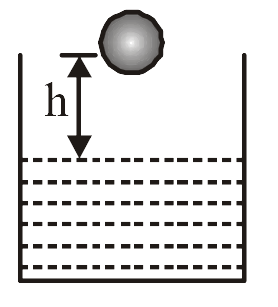In an experiment to verify Stokes law , a small spherical ball of radius r and density ρ falls under gracvity throught a distance h in air before entering a tank of wate . If the terminal velocity of the ball inside water is same as its velocity just befor entering the water surface , then the value of h is proportional to : ( ignore viscosity of air ) .
r4
r
r3
r2
To solve the problem, we need to analyze the motion of the spherical ball as it falls through air and then enters the water. We will use the concepts of terminal velocity and free fall.
1. Understanding Terminal Velocity:
The terminal velocity Vt of a sphere falling through a fluid is given by the formula:
Vt=29gr2(ρ−σ)η
where g is the acceleration due to gravity, r is the radius of the sphere, ρ is the density of the sphere, σ is the density of the fluid (water), and η is the viscosity of the fluid. However, since we are ignoring the viscosity of air, we can simplify our analysis.
2. Velocity Just Before Entering Water:
When the ball falls a distance h in air, it will have a velocity just before entering the water given by the equation of motion for free fall:
v=√2gh
where h is the height from which the ball falls.
3. Condition Given in the Problem:
According to the problem, the terminal velocity of the ball inside the water is the same as its velocity just before entering the water. Therefore, we set:
Vt=√2gh
4. Equating Terminal Velocity and Velocity Before Entering Water:
From the terminal velocity equation, we have:
29gr2(ρ−σ)η=√2gh
5. Squaring Both Sides:
To eliminate the square root, we square both sides:
(29gr2(ρ−σ)η)2=2gh
6. Rearranging the Equation:
Rearranging the equation gives us:
h=12g(29gr2(ρ−σ)η)2
7. Simplifying the Expression:
The expression for h simplifies to:
h∝r4
This indicates that the height h is proportional to the fourth power of the radius r of the sphere.
Conclusion:
Thus, the value of h is proportional to r4.
The terminal velocity Vt of a sphere falling through a fluid is given by the formula:
Vt=29gr2(ρ−σ)η
where g is the acceleration due to gravity, r is the radius of the sphere, ρ is the density of the sphere, σ is the density of the fluid (water), and η is the viscosity of the fluid. However, since we are ignoring the viscosity of air, we can simplify our analysis.
When the ball falls a distance h in air, it will have a velocity just before entering the water given by the equation of motion for free fall:
v=√2gh
where h is the height from which the ball falls.
According to the problem, the terminal velocity of the ball inside the water is the same as its velocity just before entering the water. Therefore, we set:
Vt=√2gh
From the terminal velocity equation, we have:
29gr2(ρ−σ)η=√2gh
To eliminate the square root, we square both sides:
(29gr2(ρ−σ)η)2=2gh
Rearranging the equation gives us:
h=12g(29gr2(ρ−σ)η)2
The expression for h simplifies to:
h∝r4
This indicates that the height h is proportional to the fourth power of the radius r of the sphere.
Thus, the value of h is proportional to r4.
Topper's Solved these Questions
Similar Questions
Knowledge Check
- Question 1 - Select One
A small steel ball of mass m and radius r is falling under gravity through a viscous liquid of coefficient of viscosity η. If g is the value of acceleration due to gravity. Then the terminal velocity of the ball is proportional to (ignore buoyancy)
Amg(η)rBmg(η)rCmgrηDmgrη - Question 2 - Select One
A metal ball ofradius 10−4 m and density 104kg/m3 falls freely under gravity through a distance 'h' and enters a tank of water. It is found that after entering the water, the velocity of ball does not change. What is the value of h?
[ηfor water 10−5 Pas ,g=10m/s2 and orhwater=103kg/m3]A10mB15mC18mD20m - Question 3 - Select One
A spherical metal ball of mass m and radius (r) is falling through a viscous medium. The value of its terminal velocity is proportional to
A1rBmrC√mrDm
A small ball of radius 'r' falls freely under gravity through a distance 'h' before entering a tank of water. If after entering the water, the velocity of ball does not change, the 'h' is proportional to
View SolutionA ball of radius r and density r falls freely under gravity through a distance h before entering water. Velocity of ball does not change even on entering water. If viscosity of water is η the value of h is given by
 View Solution
View SolutionA spherical ball of radius 3.0×10−4m and density 104kg/m3 falls freely under gravity through a distance h before entering a tank of water. If after entering the water the velocity of the ball does not change, find h. Viscosity of water is 9.8×106N−s/m2.
View SolutionA spherical ball of radius 3×10−4m and density 104kg/m3 falls freely under gravity through a distance h before entering a tank of water. If after entering the water the velocity of the ball does not change, find h the viscosity of water is 9.8×10−6N−s/m2
View SolutionA spherical ball of radius 3.0×10−4 m and density 104kgm3 falls freely under gravity through a distance H=n×500m before entering a tank of water. If after enerting the water the velocity of the ball does not change, then find n. viscosity of water is 10×10−6N−sm2,g=10ms
View Solution
